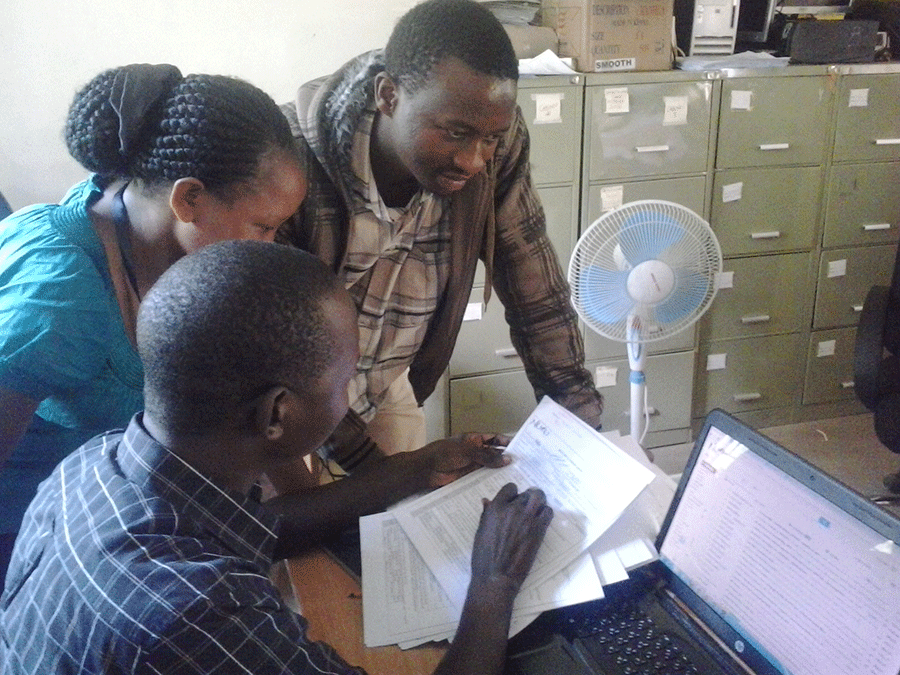Feature photo: Members of the Nuru Kenya Monitoring and Evaluation team review early results from an Agriculture Program survey.
In my two years as Team Leader at Nuru Kenya, the most critical lesson I’ve learned is the importance of making data-driven decisions. Nuru International Agriculture Program Strategic Advisor Matt Lineal puts it best: “Data first, judgment second.”
During my seven years as an active duty Marine, our units relied on the mantra “intel drives operations” for success on the battlefield. Our intel was sometimes great and sometimes, well…not so great. The quality of that processed information largely determined the outcome of our mission. Lives were on the line. I would argue the stakes are just as high in international development as in combat. The leaders at Nuru Kenya know better than anyone what’s at stake. Mission success largely depends on the team’s ability to collect, analyze and use quality data. Working alongside the Monitoring and Evaluation (M&E) Program, I’ve learned a second critical lesson: data mean nothing if they do not provide insights to improve your work.
Good data enable good insights. Good insights inform good decisions. Good decisions facilitate positive attributable impact. Positive impact means Nuru Kenya farmers’ lives are better because of the work we do alongside them, allowing us to scale what works and letting go of what does not.
Here are examples of how we make data-driven decisions at Nuru Kenya:
The Leadership Program relies on assessments to help staff trainers improve leadership curriculum and training sessions. Also, trainers disseminate a Staff Leadership Survey (SLR) semi-annually to identify what level of competency and capabilities various Nuru Kenya teams are demonstrating in managing and leading their programs.
The Agriculture Program uses key performance indicators (KPIs) to monitor specific field operations activities on a weekly basis, such as rates for planting, weeding, spraying and addressing suspected maize lethal necrosis disease cases, which enables it to counter negative trends quickly. The team piloted a diversified crop strategy in 2014, and data confirmed that a diversified strategy is a stronger food security approach for Nuru Kenya farmers, especially given the uncertainty faced regarding rain patterns and crop diseases.
The Financial Inclusion Program set three indicators along with corresponding targets in order to assess progress towards impact: 1) membership, 2) savings deposits, and 3) loans. Financial Inclusion achieved 92 percent of its 2,750 membership target for 2014; and its loan repayment rates have consistently neared or reached 100% quarter over quarter since 2010. Currently, M&E is collecting data at the household level in order to understand whether Nuru Kenya members who participate in both Agriculture and Financial Inclusion have been able to mitigate shocks by using savings or credit more frequently than Agriculture-only members. Early data suggest this is indeed the trend. This insight directly affects Nuru Kenya’s future member recruitment and enrollment strategies.
The Healthcare Program assesses whether a Nuru member household has successfully adopted ten healthy behaviors related to improving maternal and child health. M&E produced three separate scorecards that capture the improvement of maternal and child health at the household level. In addition to analyzing the aggregate data, M&E analyzed incidence rates of each behavior. Healthcare leveraged these insights to identify which geographic areas needed an increased focus regarding select healthy behaviors. The evidence demonstrates that more Nuru households are adopting behaviors related to safe pregnancy and childbirth as well as safe water, sanitation and malaria prevention in comparison with non-Nuru households.
The Education Program evaluates impact by administering an Uwezo Assessment at the beginning and end of the school year, as well as mid-year. M&E tracks student attendance and also observes students and teachers in their classrooms. In 2014, the Education team used M&E’s mid-term monitoring assessment to adjust outreach in specific schools; and because of these midstream adjustments, by the end of the year Education had positive attributable impact on the literacy proficiency and ability to read at the paragraph level for public school children in Grades 2-5.
Nuru Kenya has streamlined program monitoring by recording data in Salesforce and using intermittent memos, monitoring reports and annual impact assessment reports to produce relevant and actionable recommendations to program managers in a timely manner. Nuru Kenya not only uses data first to determine whether the program is on track towards achieving impact, but also to judge various courses of action, particularly related to scaling plans and allocating budget and resources.
Over the past two years, we’ve tightened the Nuru Model and honed our operations to become increasingly more efficient, more effective and less costly. “Data first, judgment second” has been critical to Nuru International’s ability to prove impact, build up Nuru Kenya to become completely locally-led and scale within Kenya as well as to Ethiopia.
View our impact reports here.


